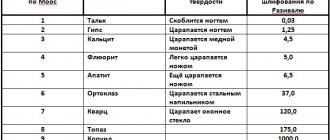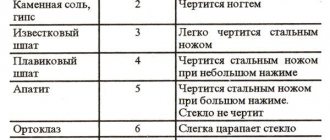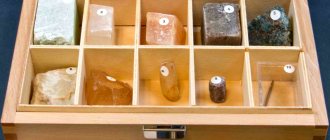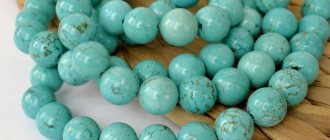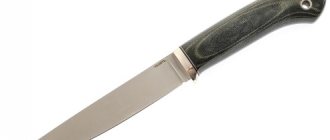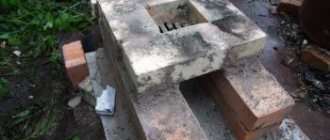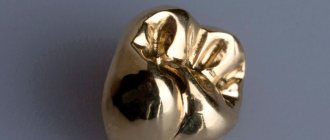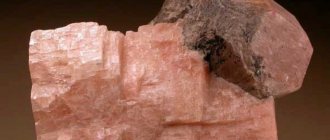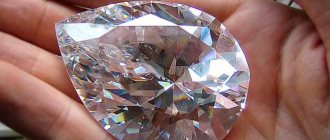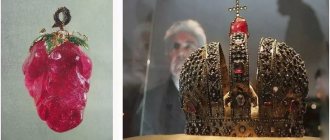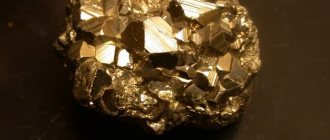Mineral hardness scale
The hardness of minerals is determined using the Mohs scale ( mineralogical hardness scale ) - a ten-point scale created for an approximate assessment of the relative hardness of materials using the scratching method. The German mineral scientist Karl Friedrich Christian Mohs developed and proposed it to his fellow geologists in 1811.
Includes ten coefficient levels with corresponding minerals. The higher the number, the harder the stone:
| Mohs hardness | Mineral(formula) | Machinability | Other minerals with similar hardness |
| 1 | Talc (Mg3Si4O10(OH)2) | Scratched with a fingernail | Graphite |
| 2 | Gypsum (CaSO4 2H2O) | Scratched with a fingernail | Halite, chlorite, mica |
| 3 | Calcite (CaCO3) | Scratched by copper | Biotite, gold, silver |
| 4 | Fluorite (CaF2) | Easily scratched by a knife or window glass | Dolomite, sphalerite |
| 5 | Apatite (Ca5(PO4)3(OH-,Cl-,F-)) | Scratched with force with a knife, window glass | Hematite, lapis lazuli |
| 6 | Orthoclase (KAlSi3O8) | Scratches glass. Processed with a file | Opal, rutile |
| 7 | Quartz (SiO2) | Can be treated with diamond, scratches glass | Garnet, tourmaline |
| 8 | Topaz (Al2SiO4(OH-,F-)2) | Can be treated with diamond, scratches glass | Beryl (heliodor, aquamarine, emerald), spinel |
| 9 | Corundum (Al2O3) | Can be treated with diamond, scratches glass | Varieties of corundum - sapphire, ruby |
| 10 | Diamond (C) | Cuts glass | Elbor is close, but there is no natural analogue |
Stones with positions 1–6 are considered soft. That is, according to the Mohs scale, the list of soft minerals is as follows: talc, gypsum, calcite, fluorite, apatite, orthoclase.
Synthetic analogues and imitations
Synthetic ruby for the jewelry industry is produced by several methods based on different physical principles:
- gas-flame method of crystallization of the molten phase (Vernel method);
- methods based on the principle of “pulling” from the melt (Czochralski method, etc.);
- methods based on the principle of zone melting (methods of Bagdasarov, Stockbarger, etc.);
- methods of crystallization from a solution in a melt (group of flux methods)
- methods of crystallization from aqueous solutions (hydrothermal method group).
The following are used as ruby imitations:
- corundum, colored by cavity filling method;
- surface-coated corundum;
- corundum with a layer of artificially grown ruby;
- diffusion-treated corundum;
- doublet: corundum+glass and corundum+garnet;
- natural and synthetic minerals with similar colors;
- colored glass.
Soft minerals from the Mohs scale: characteristics
Apatite, calcite, talc, fluorite, gypsum, orthoclase are not classified as rare stones: their mining is established throughout the planet.
Talc
The softest stone on the Mohs scale: talc hardness – 1. It is a dense, layered, greasy-to-the-touch stone from the silicate class. The color scheme is white, grayish, pinkish shades. Even a slight mechanical impact turns the softest mineral into powder.
Talc is used as a powder: for children, sports, for technical rubber (prevents mutual adhesion of parts). Noble transparent light soft talc is a component of cosmetic powder.
The most famous variety of talc is steatite (also known as wen, soapstone, wax, ice or soapstone). Common colors are white, gray, brown, green, yellow. Specimens of ripe cherry and red color are rare. Silky agglomerates with a matte sheen have found application as a decorative material.
Talc is the softest mineral
Graphite has the same degree of hardness (this is the closest relative of diamond), and molybdenite has a similar degree of hardness.
Gypsum
The second hardest in the table. Classic – white mineral. Other colors are grayish, brownish, reddish, light brown. Yellow natural plaster looks beautiful.
Gypsum is used depending on the variety:
- ordinary - in medicine in the treatment of fractures;
- fibrous - called selenite; used as a decorative and ornamental material;
- a fine-grained variety of gypsum is called alabaster; used as a decorative and building material.
Gypsum
Similar hardness is found in halite, mica, chlorite, ulexite, chrysocolla, muscovite.
Calcite
A common mineral that makes up marls, limestones, marble, and chalk deposits. As well as mollusk shells, which is why it is called a biomineral.
Third on the Mohs scale: you can scratch it with a copper coin.
White calcite
It can be white or colorless. Brownishness, pinkishness, and greenness are created by inclusions of iron, nickel, and other impurities. The most famous variety is Iceland spar.
Amber, serpentine, biotite, chrysocolla, and jet have similar hardness values.
Fluorite
The name of the mineral translates as “fluid”:
- You can only scratch it with glass or a knife.
- The stone is fragile, the color range is violet, greenish, pinkish, reddish. Or lack of color.
- Raw materials containing uranium, thorium, and other rare earth elements are valued. Common raw materials are used by metallurgists to increase the fusibility of slag.
- Beautiful specimens are used by stone cutters.
- The material is also known as fluorspar.
Fluorite
Other similar minerals are dolomite (the oldest building material), pearls, corals, malachite, sphalerite, azurite, aragonite, rhodochrosite.
Apatite
Apatite has a Mohs hardness of 5:
- Scratched with glass or a knife.
- Crystals are elongated prisms or tables with greenish, bluish, yellowish-green, pinkish. Their configuration and color make apatite similar to tourmaline or beryl.
- Used in the production of phosphorus, its acid, and fertilizers.
A similar characteristic is found in hematite, rutile, obsidian, turquoise, lapis lazuli, and rhodonite. True, for hematite 5 is an average value: crystals have a hardness of 6, and ocher has a hardness of 4.
Apatite
Minerals such as turquoise, rhodonite, and lapis lazuli are used as jewelry.
Orthoclase
Hardness on the Mohs scale is 6. You can't scratch it with glass, only with coarse sandpaper.
Orthoclase
A common mineral from the feldspar class. It is contained in granites, pegmatites, syenites, and gneisses.
Areas of use:
- Opaque, as an ornamental material, it is rarely used; it is almost always a source material for technical ceramics.
- Exceptions are colorless adularia or bluish moonstone. These varieties are taken by jewelers.
- High-quality transparent, colorless, yellow specimens also replenish mineralogical collections.
Rutile, pyrite, moldavite, jade, labradorite, larimar, benitoite, and opal have a similar strength.
Types of rubies
If you are looking for an answer to the question of how to distinguish a ruby, it is worth considering what types of stones nature has created. There are not many varieties.
Burmese. Named after the place of extraction, samples are found in Myanmar. The red color is very bright and saturated, the stone is quite expensive, so you can distinguish a ruby from a fake just by the price. High prices are set only for certified goods.
Ring with Burmese ruby and diamonds
Pigeon blood. Distinguished by the appearance of a purple glow, ruby is very valuable, its price is similar to diamonds, it is difficult to counterfeit the stone, you will have to combine several ingredients with metallic impurities, trying to preserve the special properties. These actions are practically impossible.
ruby pigeon blood
Star-shaped, the rarest type of crystal that can be found, the inner glow is similar in shape to a star, it is unlikely that even the most skilled craftsman will be able to reproduce such a miracle of nature.
Other soft minerals
Minerals from the Mohs scale are considered reference minerals because they retain their hardness coefficient regardless of external factors.
Later, other stones of similar hardness were added to them.
But most of them cannot be samples, since they change hardness in different states of aggregation, compounds or varieties. As an example, amber with an index of 2–3, corals, pearls (3–4), ilmenite, lapis lazuli, turquoise (5–6), soapstone (1–5.5).
The matter was complicated by the so-called “half” hardness coefficients:
- opal, hematite, rhodonite – 5.5–6.5;
- jet – 2.5-4;
- alabaster – 2-2.5;
- molybdenite – 1-1.5.
Minerals with similar characteristics sometimes appear on adjacent levels of the scale. For example, the hardness rating of jet can be 2, 3 or 4.
How is ruby different from corundum?
For the uninitiated, corundum and ruby are the same minerals, since both stones are bright red in color with a characteristic shine, are resistant to mechanical and chemical influences, are very hard and do not have adhesion. How are they different? To understand, it is important to know what exactly corundum is, since we are already dealing with ruby.
Corundum is a hard and durable mineral, second only to diamond. In the natural environment, it occurs both in the form of single crystals and in the form of crystals arranged in columns. Primary colors of corundum:
- black;
- red;
- green;
- pink;
- white.
This wide range of colors is one of the main differences between this gemstone and ruby, which only comes in shades of red and burgundy.
Sapphire, amethyst and leucosapphire are also varieties of gemstones, and it is believed that rubies are sapphires that are not fully mature. After the collapse of Pangea (a single ancient continent), a large deposit of stones was destroyed, as a result of which some of the rubies remained in the ground, and some were under water. The first was saturated with metallic impurities and acquired a characteristic red color, while the second received blue, yellow and other shades.
How to identify soft minerals
A general property of soft stones is that they are easy to damage (for example, scratch):
- plaster - nail;
- calcite – with a coin;
- fluorite - with a piece of glass, a knife;
- apatite - with a piece of glass, a knife (with some effort);
- orthoclase - with coarse sandpaper.
The talc (number 1) is scraped off with a fingernail.
All soft stones can be scratched with glass or a knife. Starting with quartz (6 on the Mohs scale), minerals scratch themselves.
Quartz, for example, leaves a mark on glass.
Where are soft stones used?
Low hardness plus other properties determine the areas of use of soft minerals:
- Soft rocks rarely act as independent players, more often serving as raw materials for production processes or as a component of complex substances. For example, rare earth metals are obtained from soft molybdenite; it is added to lubricants and used in radio engineering.
- The best samples become exhibits of mineralogical collections or decorative and ornamental materials.
- The most famous soft ornamental stones are gypsum and its variety selenite. Both are excellently processed with cutting tools.
Soft stones make beautiful boxes, figurines, balls, pyramids, and other small plastic items.
